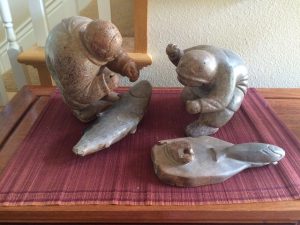 Stone sculptures purchased on vacation in British Columbia were the only items in my father’s house to (mostly) survive the October 1991 Oakland Fire.
Stone sculptures purchased on vacation in British Columbia were the only items in my father’s house to (mostly) survive the October 1991 Oakland Fire.
Just after 5:30 a.m., last October 9, I got a text from my half-sister letting me know that she and her children were safe at her mother’s house, but that her own home just outside Santa Rosa, California, had very likely burned. She’d awakened after midnight to the smell of smoke, and upon investigation discovered that wildfire was below her hill. Throwing on clothes, she and her kids evacuated down their winding, country road, as she blasted her car horn all the way down to alert neighbors of the danger. It appeared that Jennifer had become the one in our generation to be tapped by the finger of our family curse.
In my last post, I traced the first known instance of destructive fire in my family to 1836, with several more fires – great and small – over the succeeding decade up to Nantucket’s “Great Fire,” which still features prominently in the island’s history. But when my family left the island, they didn’t leave their fire troubles behind.
When my great-great-grandfather, Frederic William Athearn (1842–1881), moved to Southern California, he became co-owner and editor of the Anaheim Gazette. On 16 January 1877, a fire swept through part of Anaheim’s downtown, and according to a history of the town focused on this period,[1] the Gazette owners “were able to save their account books, but lost all of their printing equipment to the flames, including the Washington handpress that had once printed the Los Angeles Star,” Southern California’s first newspaper.
Almost thirty years later, this man’s only surviving son was on a Southern Pacific train headed for El Paso, Texas, when a telegram reached him with news of the April 1906 earthquake and fire in San Francisco. Fred Goodrich Athearn’s wife was back at their home just south of the Golden Gate Park, expecting their first baby that summer.
“Slight earthquakes were occurring about every 15 or 20 minutes and the whole town was still ablaze, and buildings were being blown up with dynamite to stop the progress of the fire.”
My great-grandfather hurried home, where he found my great-grandmother camping with her mother in a vacant lot near their former home. “Slight earthquakes were occurring about every 15 or 20 minutes and the whole town was still ablaze, and buildings were being blown up with dynamite to stop the progress of the fire,”[2] he would recall. I’m not sure whether my great-grandparents’ own residence actually succumbed to flames, but twenty years later they acquired a pleasure boat whose engine exploded, fire consuming what had been my grandparents’ floating “honeymoon cottage.”
These grandparents, Folger and Marion Athearn, had their own home greatly damaged – though not utterly destroyed – by fire in the late 1970s. My grandfather left something simmering on the stove while he went to the grocery store, and returned to find his street blocked by fire engines. It was a windy day, and flaming pieces of their roof were being torn off and dropped onto neighboring houses. Fortunately the fire was extinguished before it spread to other structures, but many family photographs and keepsakes were damaged or destroyed.
Then on 20 October 1991, my father and stepmother stopped at a home supply store on their way back from church, where they purchased the very last light fixture for a years-long remodeling project. As they drew near their house, they could see a wildfire. Firefighters thought they’d extinguished a grass fire miles away the previous night, but “Diablo Winds” of up to 65 miles per hour had reignited it around 11:00 a.m. Dad hoped that by spraying down the house and vegetation with water, they might avert disaster … but then a roaring wall of fire surged, and they knew they had to get out immediately. Their house was the last one on the street to be consumed, one of more than 3,000 homes lost in the conflagration.
As for Jennifer’s house outside Santa Rosa? It actually survived, though sadly five percent of homes in her community were destroyed. So I guess I’d better make sure that my homeowner’s policy is up-to-date … just in case I turn out to be “The One”!
Notes
[1] Leo J. Friis, When Anaheim was 21 (Santa Ana, Calif.: Pioneer Press, 1968), 56.
[2] Fred Goodrich Athearn, "A Story of a California Boy" (unpublished manuscript, 1957).
Share this:

About Pamela Athearn Filbert
Pamela Athearn Filbert was born in Berkeley, California, but considers herself a “native Oregonian born in exile,” since her maternal great-great-grandparents arrived via the Oregon Trail, and she herself moved to Oregon well before her second birthday. She met her husband (an actual native Oregonian whose parents lived two blocks from hers in Berkeley) in London, England. She holds a B.A. from the University of Oregon, and has worked as a newsletter and book editor in New York City and Salem, Oregon; she was most recently the college and career program coordinator at her local high school.View all posts by Pamela Athearn Filbert →